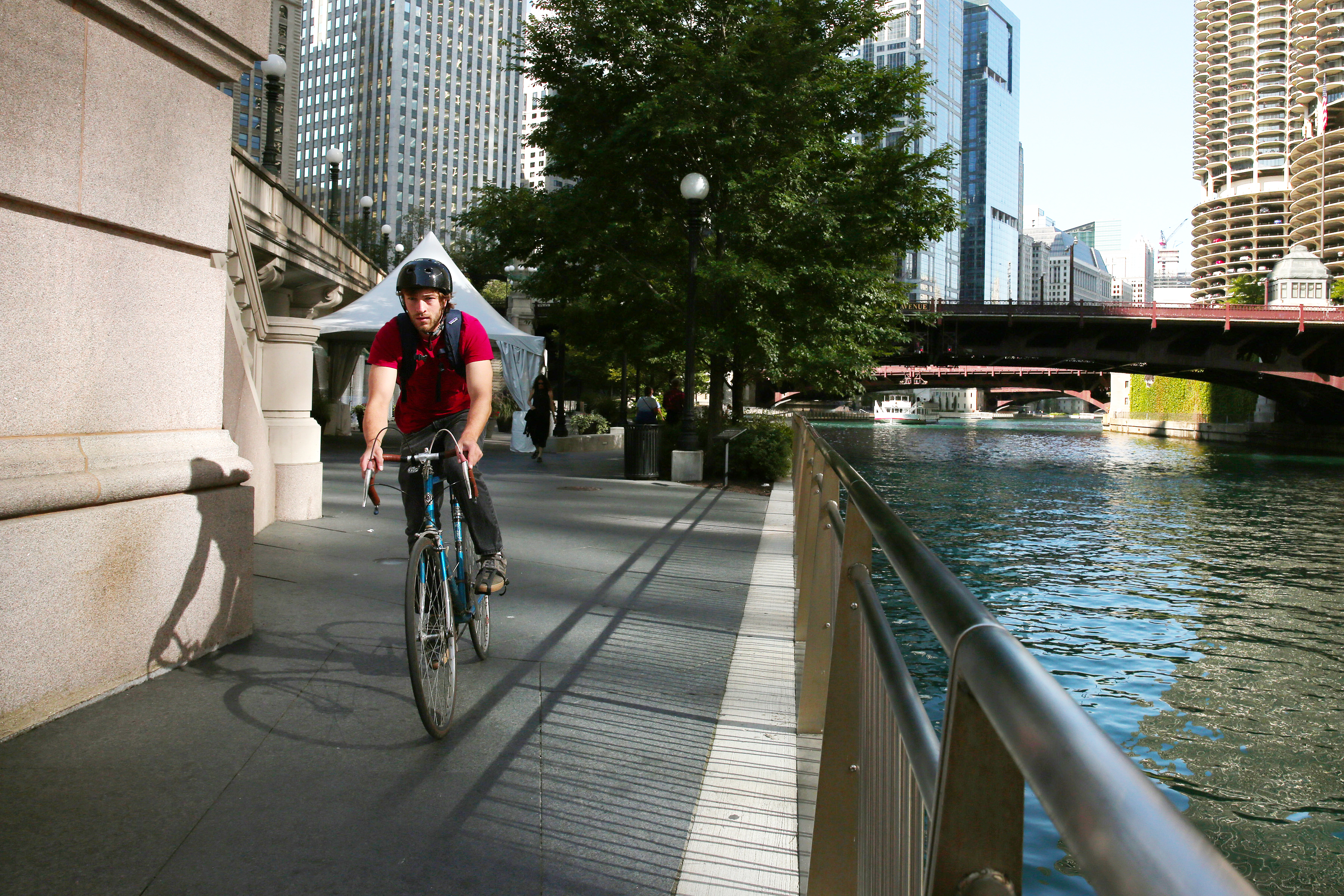Stroll down the Chicago Riverwalk on a nice day, and you’ll see the long-promised vision of a “second waterfront” for the city come to life.
Young professionals relax on their lunch breaks or sip rosé at happy hour. Locals tote grocery bags stuffed with toilet paper while tourists roll suitcases and artists sketch the curves of buildings and bridges. You’ll pass public art, war memorials, and a “party hut” with ping-pong and giant Jenga.
But what’s missing from the picture, if you ask some of the city’s cyclists, is an acceptable space for them to ride.
“One of the reasons we were excited about [the Riverwalk] is that it was billed as a transportation corridor and the city specifically said that biking would be allowed on it,” says John Greenfield, editor of Streetsblog Chicago, who notes that he’s been covering and promoting the project on the site for years.
Financing for the project came from a $99 million federal TIFIA loan, points out Jim Merrell, managing director of advocacy at the Active Transportation Alliance, the walking, cycling, and public transit advocacy group.
TIFIA stands for the Transportation Infrastructure Finance Innovation Act, and if you peek at the project’s description on the U.S. Department of Transportation website, the wording suggests cycling played a role in the proposal: “The project will enhance safety for pedestrians with bicycle paths and pedestrian trails along the continuous promenade.”
But, a city spokesperson says via email, the primary goal was always safe passage for pedestrians. And as the park’s popularity has grown, policies have evolved to preserve that.
Evidence of the shift emerged last summer, when signs appeared asking cyclists to share the Riverwalk by walking their bikes. Security guards began flagging down riders, asking them to dismount even when the path wasn’t crowded, Greenfield says.
When Greenfield pointed out on Streetsblog the lack of a legal basis for the instruction, 42nd Ward Alderman Brendan Reilly responded by attempting to provide it, introducing an ordinance to city council last September to ban bikes from the Riverwalk altogether.
“We were disconcerted by that development,” Merrell says, and notes the lack of publicly available data to suggest it’s necessary. The Chicago Department of Transportation doesn’t track bike incidents there; the city spokesperson said fewer than 10 complaints have been lodged through the Riverwalk website. (The alderman’s office didn’t return calls for comment.)
The ban never passed, but around the same time, new signs went up at entrances to the park. “Bicycles must be walked,” they warn; for that and other infringements — smoking, skateboarding, and peddling — you can be charged.
The situation heated up again in the past month, as warmer weather brought crowds back to the water. Plus, the city redesigned the eastern section of the Riverwalk, starting at Michigan Avenue. The update changed a straight, asphalt, “low-stress” bike path connecting Lake Shore to the Loop into a jagged route far less friendly to cyclists, Greenfield says.
The specifics came as a surprise even to those following the project closely, Merrell says: “We read about the redesign and the plans in the Chicago Tribune.”
In response, Greenfield has done a bit of what he calls “IRL trolling,” pedaling the route in a hand-lettered T-shirt: “Hi there! Despite what the signs say, Alderman Reilly’s ordinance to ban biking on the riverwalk (O2018-7034) never passed, so it’s still legal. Thank you!”
Amid a few more Twitter jabs — Greenfield recently posted a snapshot of the city’s official bike map last week, which lists the Riverwalk as a cycling route; Reilly shot back: “The beauty of maps? They change all the time …” — Reilly reintroduced the ban on May 29.
Unless and until it passes, there’s no legal penalty for cycling on the route, says Michael Claffey, director of public affairs for the Chicago Department of Transportation. For a while, security guards were allowing cyclists to ride only between 6 a.m. and 9 a.m. Currently, the official policy allows it “when the Riverwalk is not congested.”
That aligns with the type of “common sense” approach Active Trans has asked for, in which cyclists would be allowed to ride anytime it’s reasonably safe to do so. That’s an approach Greenfield says he can live with, too.
But for that reason, the Riverwalk won’t work as a long-term solution for many two-wheeled commuters. Right now, those who want to avoid the route during high-traffic hours could consider the protected bike lane on Randolph Street, which stretches from the Lakefront Trail to Michigan Avenue, Claffey says.
Additionally, Active Trans is working with a group of stakeholders — including CDOT; Ross Barney Architects, which designed the Chicago Riverwalk; neighborhood organization Friends of Downtown; and Alderman Reilly’s office — on a better solution. This could include a protected bike lane on Upper Wacker Drive, which has “a lot of excess capacity,” Merrell says.
Even if he’s a bit salty about the Riverwalk bait-and-switch, Greenfield commends the effort. “That’s kind of a positive sign of the times,” he says. “Ten years ago, it was just not considered something that could be done, to take a lane away from drivers and give it to bicyclists. Now, it’s a pretty mainstream thing to do.”
Cyclists or pedestrians who have comments about traffic on the Riverwalk can contact Fleet and Facility Management, the city department that manages the Riverwalk, via chicagoriverwalk.us or by email at chicagorivrewalk@cityofchicago.org; Active Trans will also offer updates and the opportunity for public input as the Wacker Drive discussions continue.



